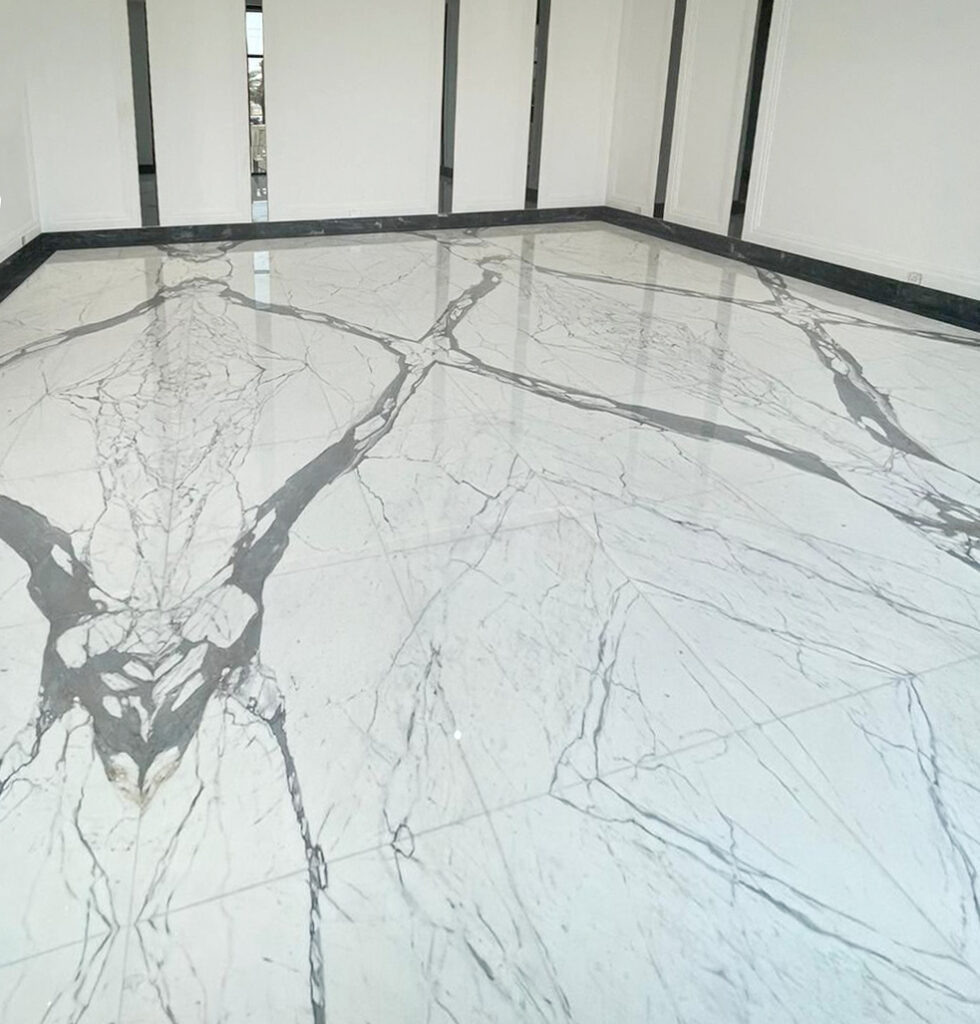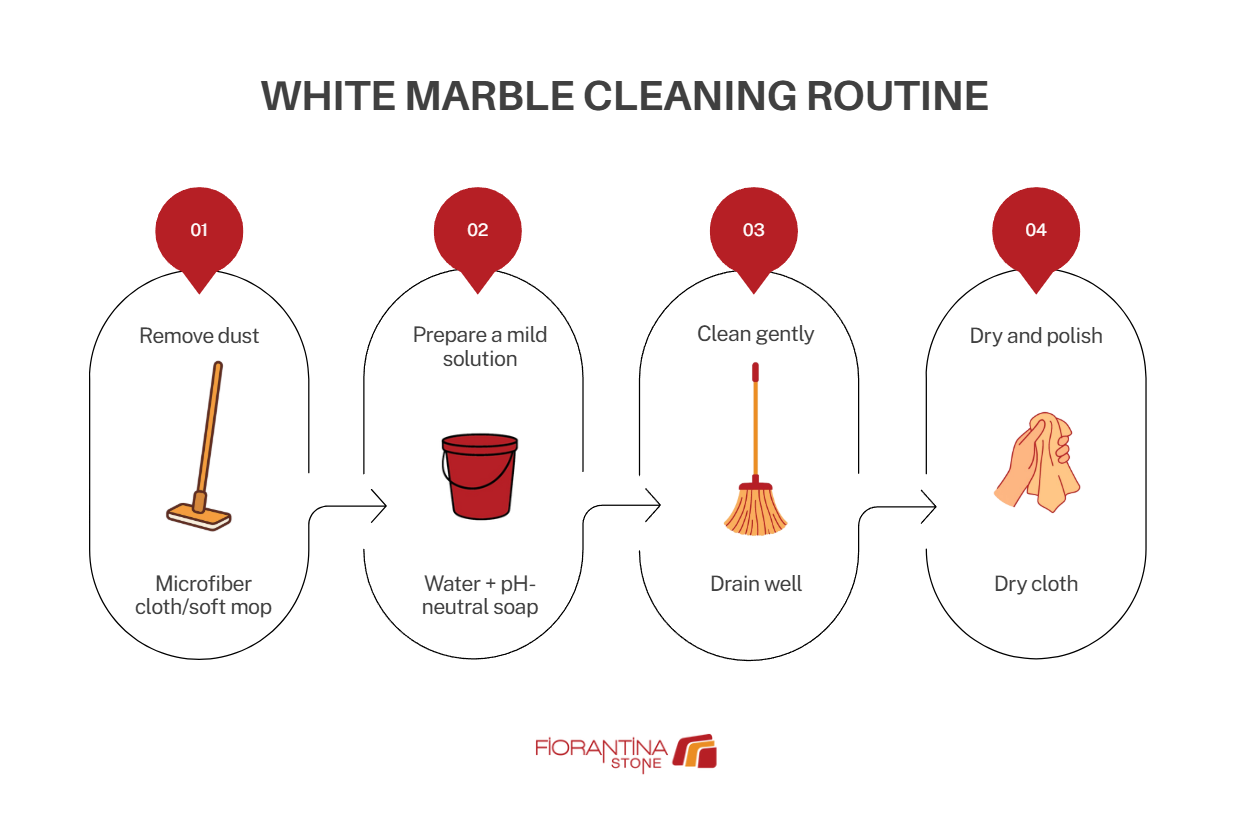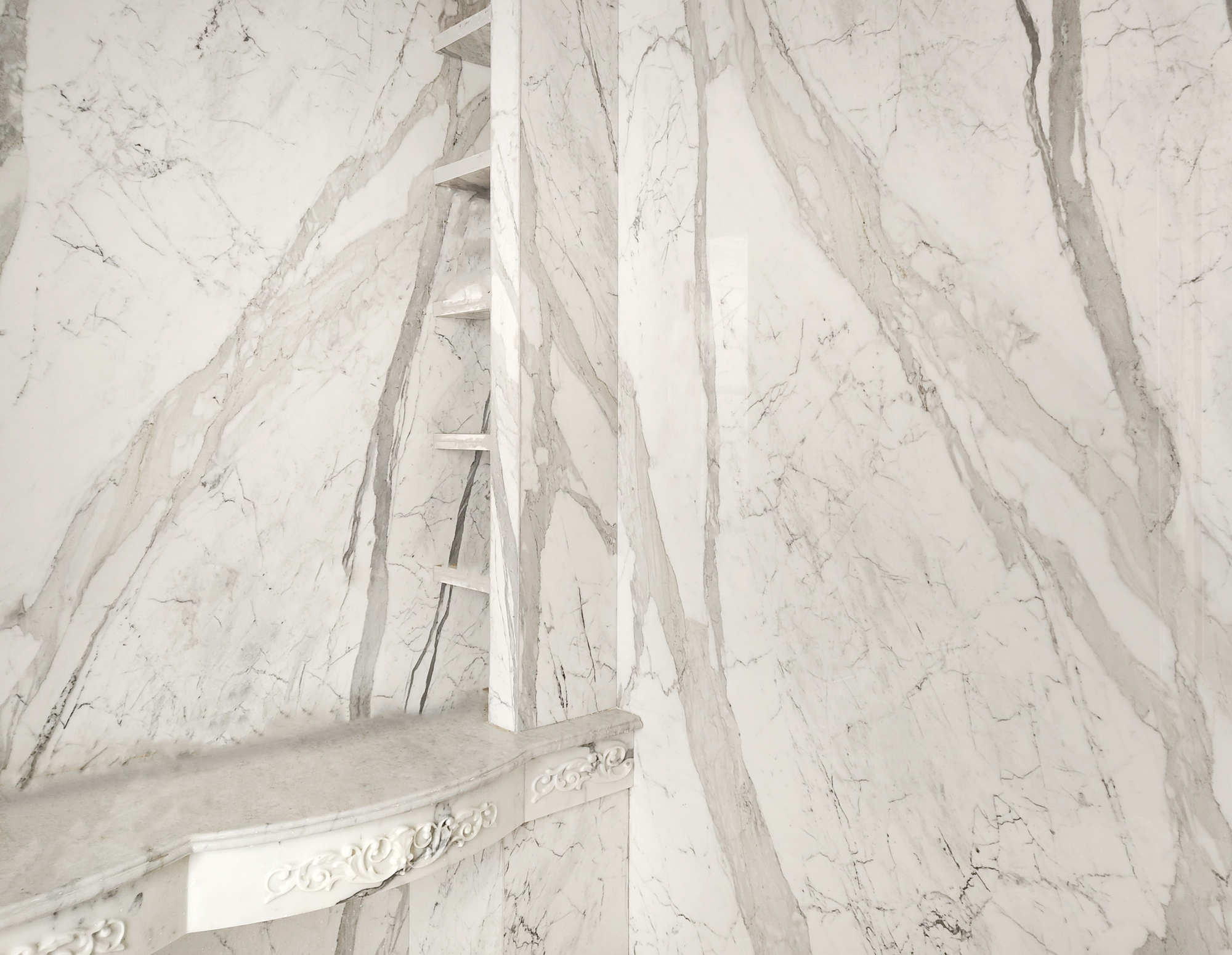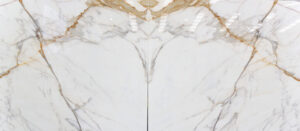Brilliant, pure, and timeless, white marble is a classic that never goes out of style. From clad bathrooms to floors and walls that become the center of attention, this material brings light, elegance, and spaciousness to any space.
In this guide, we show you step by step how to clean white marble, remove stains, and keep it looking like new.
Contents
Factors that can damage white marble
Before talking about cleaning, it’s important to understand what can damage marble in order to prevent it. With all natural materials, you should avoid certain harmful products and take the recommended care for this this of surface and follow the recommended care for this type of surface.
- Harsh chemicals: avoid vinegar, bleach, ammonia, and acidic cleaners, as they deteriorate the sealant and erode the surface.
- Rusty metal objects: avoid rusty tools, decorations, or containers that can leave rust stains on the surface.
- Moisture: avoid leaving water or steam for long periods, as excess humidity can cause marks and promote mold growth.
- Do not use metallic or abrasive scouring pads: these cleaning tools scratch the sealant and dull the surface.
Keeping marble free from these factors not only preserves its beauty but also extends its lifespan. In addition, proper sealing is essential: it reduces liquid absorption, makes daily cleaning easier, and helps maintain the original color and texture. We recommend renewing the sealant once it starts losing its properties over time to prevent leaks and damage.
Is white marble delicate?
You may wonder why white marble is commonly known for being delicate. White marble is a natural material primarily composed of calcite. It is distinguished by its luminous whiteness and veins that can range from gray to golden tones, depending on its origin. Its composition gives it a natural shine and a surface that brings spaciousness and brightness to any setting.


One of the properties that determines how delicate marble can be is its porosity. Natural stone can absorb liquids and react to acidic substances such as lemon, vinegar, or wine, which may cause stains or loss of shine. While some marbles are more porous than others, this characteristic directly affects their resistance to stains and their ease of maintenance.
Not all marbles are the same: some are more compact and less absorbent, while others are more porous and require extra care. Factors such as the surface finish (polished, matte, honed, etc.) and the application of protective treatments like sealants also influence how the material performs in daily use.
For this reason, when purchasing marble, it is always advisable to seek professional guidance to choose the best option depending on where it will be installed and the type of use it will have.
If you have any questions about which type of marble to use, please contact us using our form.
How to clean white marble step by step
With the right care and products, maintaining marble is quite simple. At Fiorantina, we’ve prepared a cleaning routine for keeping white marble in top condition:
- Remove dust and surface dirt – Use a dry microfiber cloth or a soft mop to avoid scratching the surface.
- Prepare a gentle cleaning solution – In a bucket of water, add one tablespoon of pH-neutral soap or another cleaner specifically designed for natural stone, which often contains protective properties that reinforce the sealant. The products used must be non-abrasive and acid-free, as harsh cleaners can damage the surface layer and significantly reduce its shine.
- Clean gently – Use a well-wrung mop to apply the solution onto the marble. Be careful not to soak the surface, since excess water is not recommended. Rinse with clean water to remove any soap residue and prevent streaks.
- Dry and polish the marble – Use a dry microfiber cloth or a chamois for a flawless finish.

However, to preserve the shine of natural stone, it is advisable to schedule professional maintenance periodically. Polishing or deep cleaning helps restore the stone’s original appearance and remove stubborn stains that do not disappear with regular care.
Products you should avoid to clean white marble
Even though the goal is to leave it spotless, certain substances can cause irreversible damage. Here’s a list of products we often use for cleaning but that, in the case of natural stone, we do not recommend:
- Acids: vinegar, lemon, citrus fruits, hydrochloric acid, or phosphoric acid
- Ammonia
- Bleach
- Degreasers with very high pH
- Abrasive powders
- Metal scouring pads
- Alcohol
TIP: For daily cleaning, warm water and a neutral soap are more than enough.
How to clean yellowed white marble
Over time, white marble can develop a yellowish tone due to several factors: accumulation of dust and grease, the use of inappropriate cleaning products, retained moisture, or even the natural wear of the stone. Although it is not always possible to restore 100% of its original whiteness, in many cases its appearance can be significantly improved with proper care.
With the home cleaning methods mentioned earlier, the stone can be kept in very good condition. However, if the yellowing is very deep, the best option is to resort to professional polishing. This process removes the most superficial layer of the stone and restores a brighter appearance. In addition, the treatment is usually completed with a sealant to protect this new layer from future stains.
There are also some home remedies that can help improve the look of yellowed white marble (always bearing in mind that these are not substitutes for professional polishing):
- Bicarbonate with water: prepare a soft paste of baking soda and water and apply it to the surface with a microfiber cloth. Leave it on for a few minutes, then remove with clean water and dry the area thoroughly.
- Hydrogen peroxide (20–30 vol.): for heavily yellowed marble, it can be carefully applied to the stain with a cotton ball or cloth. Leave it on for a few minutes, then rinse thoroughly with plenty of water.
How to clean white marble in the kitchen
On kitchen countertops, white marble is exposed to grease, coffee, wine, or citrus. To clean marble in the kitchen, apply the methods explained above. The key for this type of surface is to wipe up spills immediately with absorbent paper and wash the surface with neutral soap.
Avoid using metal scouring pads commonly found in the kitchen, as well as the abrasive products mentioned earlier.
Keep countertops dry and renew their sealant from time to time to prevent deep stains.
How to remove stains from white marble
Grease Stains
To remove grease residues (oils, cosmetics, etc.), prepare a thick paste with baking soda and water. Apply the mixture to the affected area, cover it with plastic wrap, and seal the edges with adhesive tape to preserve its properties. Leave it on for a few hours, then remove the paste and clean with a damp cloth.
Organic Stains
These types of stains (wine, coffee, food, etc.) often leave a dark tint on the surface. To treat them, use 3% hydrogen peroxide applied with a soft cloth. Cover the area to enhance the whitening effect and let it sit until the stain fades. Finally, rinse with clean water and dry carefully.
Rust on Surfaces
If rust stains appear, usually caused by metal objects in contact with the stone, it is essential to act quickly. To clean rust from white marble, use a mixture of water with a cleaner specifically designed for natural stone. Avoid overly aggressive household products like vinegar or acids, as they can damage the surface. For this type of stubborn stain, the most recommended solution is professional polishing.
Mold Outdoors
In outdoor areas, where humidity can cause mold to develop, the first step is to clean the area with water and a soft-bristle brush to remove as much surface mold as possible. Then, clean the area with a natural stone cleaner with antimicrobial action, rinse, and dry thoroughly.
In persistent cases, you can use a solution of water with a few drops of hydrogen peroxide or mold removal products, making sure they contain no chlorine or acids.
As a preventive measure, it is advisable to apply a breathable water-repellent or sealer to the stone, which helps reduce moisture absorption and prevents mold from appearing in the future.
Shine and purity that last over time
Each piece of white marble is a fragment of history that deserves to be preserved. Using neutral soap, acting quickly on spills, applying baking soda on persistent stains, and sealing the surface are some of the keys to keeping it in perfect condition.
Remember that knowing how to clean white marble makes all the difference in preventing damage and preserving its purity. If you know how to clean yellowed white marble, act quickly when spills occur, and apply the proper sealing, you will enjoy its brightness and elegance for many years.






